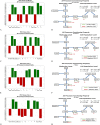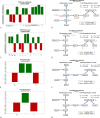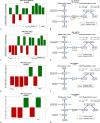A Mathematical Analysis of Aerobic Glycolysis Triggered by Glucose Uptake in Cones
- PMID: 30858444
- PMCID: PMC6411757
- DOI: 10.1038/s41598-019-39901-z
A Mathematical Analysis of Aerobic Glycolysis Triggered by Glucose Uptake in Cones
Abstract
Patients affected by retinitis pigmentosa, an inherited retinal disease, experience a decline in vision due to photoreceptor degeneration leading to irreversible blindness. Rod-derived cone viability factor (RdCVF) is the most promising mutation-independent treatment today. To identify pathologic processes leading to secondary cone photoreceptor dysfunction triggering central vision loss of these patients, we model the stimulation by RdCVF of glucose uptake in cones and glucose metabolism by aerobic glycolysis. We develop a nonlinear system of enzymatic functions and differential equations to mathematically model molecular and cellular interactions in a cone. We use uncertainty and sensitivity analysis to identify processes that have the largest effect on the system and their timeframes. We consider the case of a healthy cone, a cone with low levels of glucose, and a cone with low and no RdCVF. The three key processes identified are metabolism of fructose-1,6-bisphosphate, production of glycerol-3-phosphate and competition that rods exert on cone resources. The first two processes are proportional to the partition of the carbon flux between glycolysis and the pentose phosphate pathway or the Kennedy pathway, respectively. The last process is the rods' competition for glucose, which may explain why rods also provide the RdCVF signal to compensate.
Conflict of interest statement
The authors declare no competing interests.
Figures









References
-
- Camacho ET, Melara LA, Villalobos MC, Wirkus S. Optimal control in the treatment of retinitis pigmentosa. B. Math. Biol. 2014;76:292–313. - PubMed
Publication types
MeSH terms
Substances
LinkOut - more resources
Full Text Sources
Other Literature Sources

